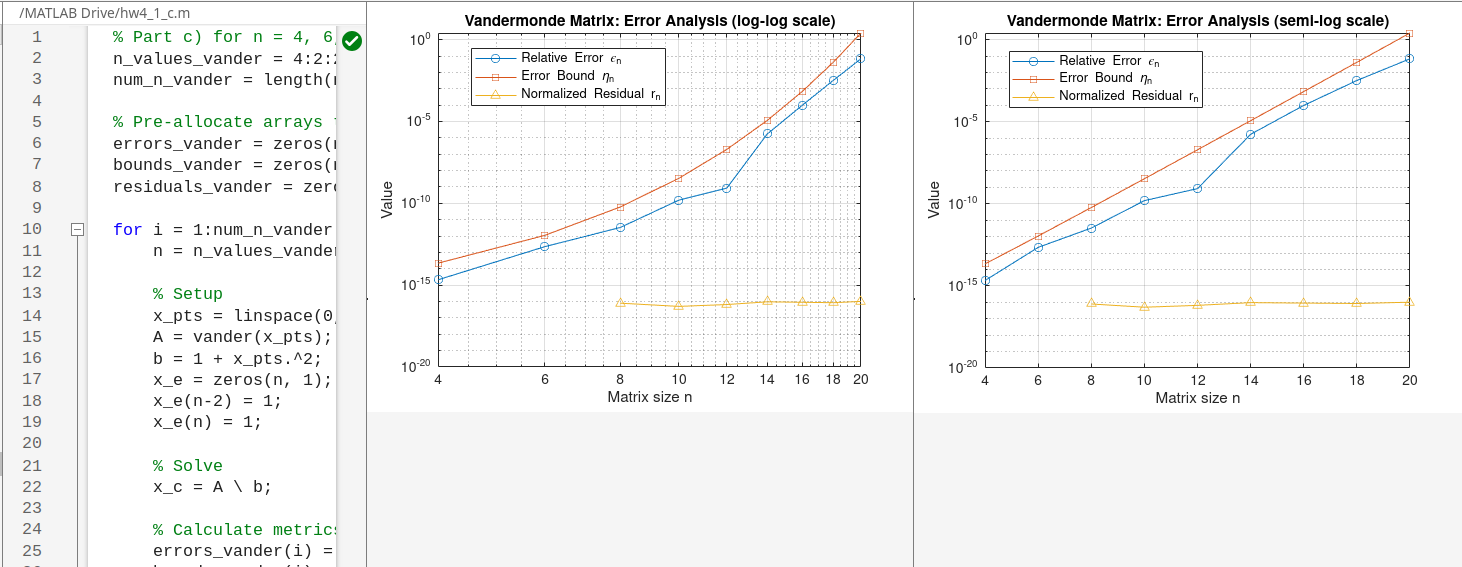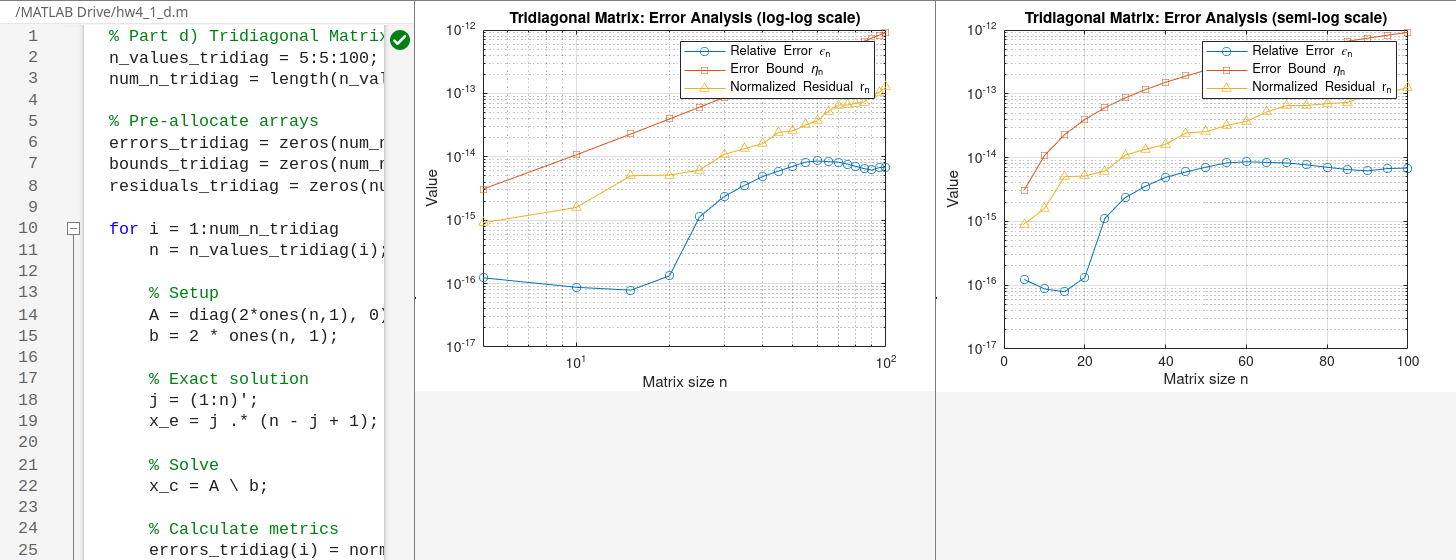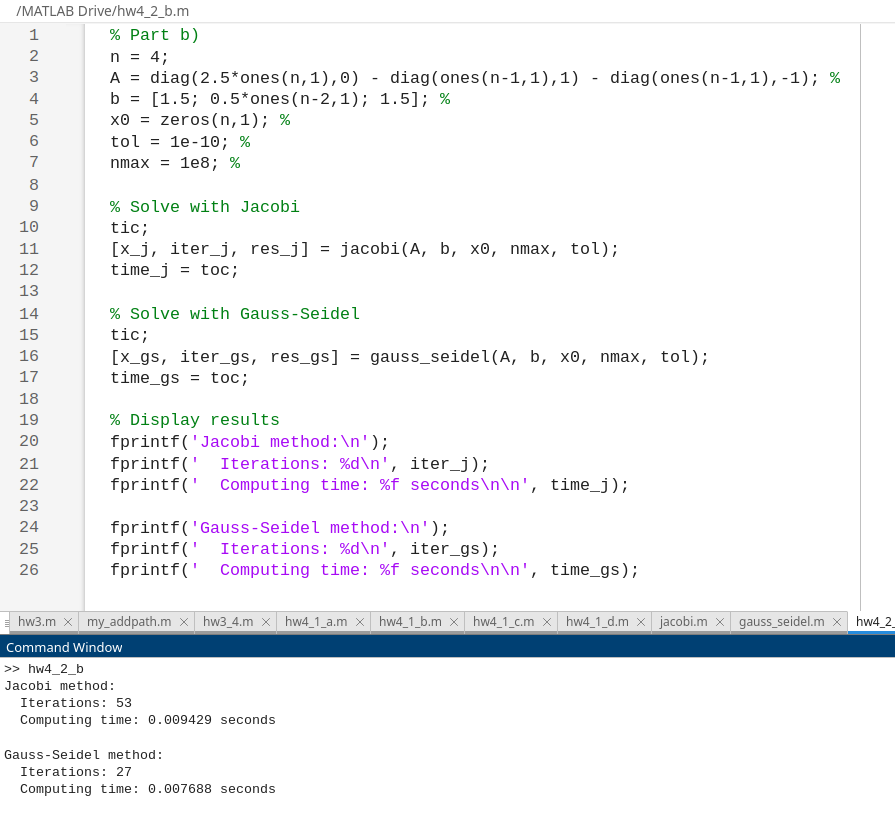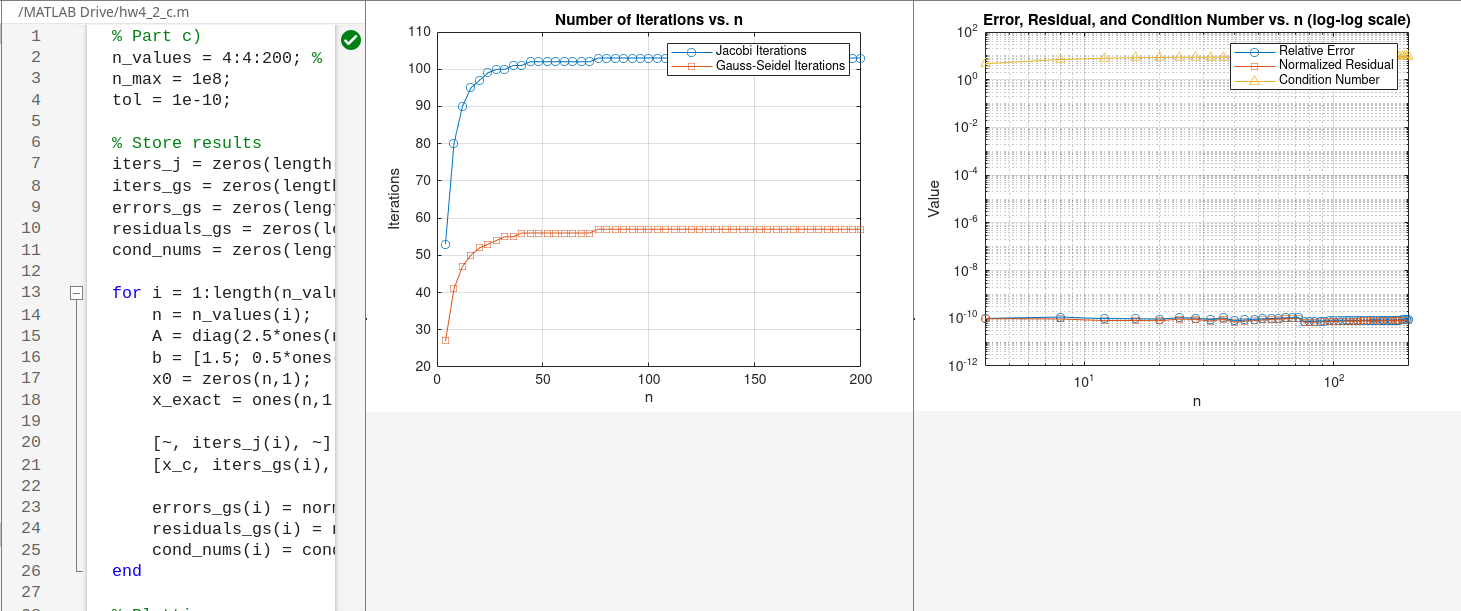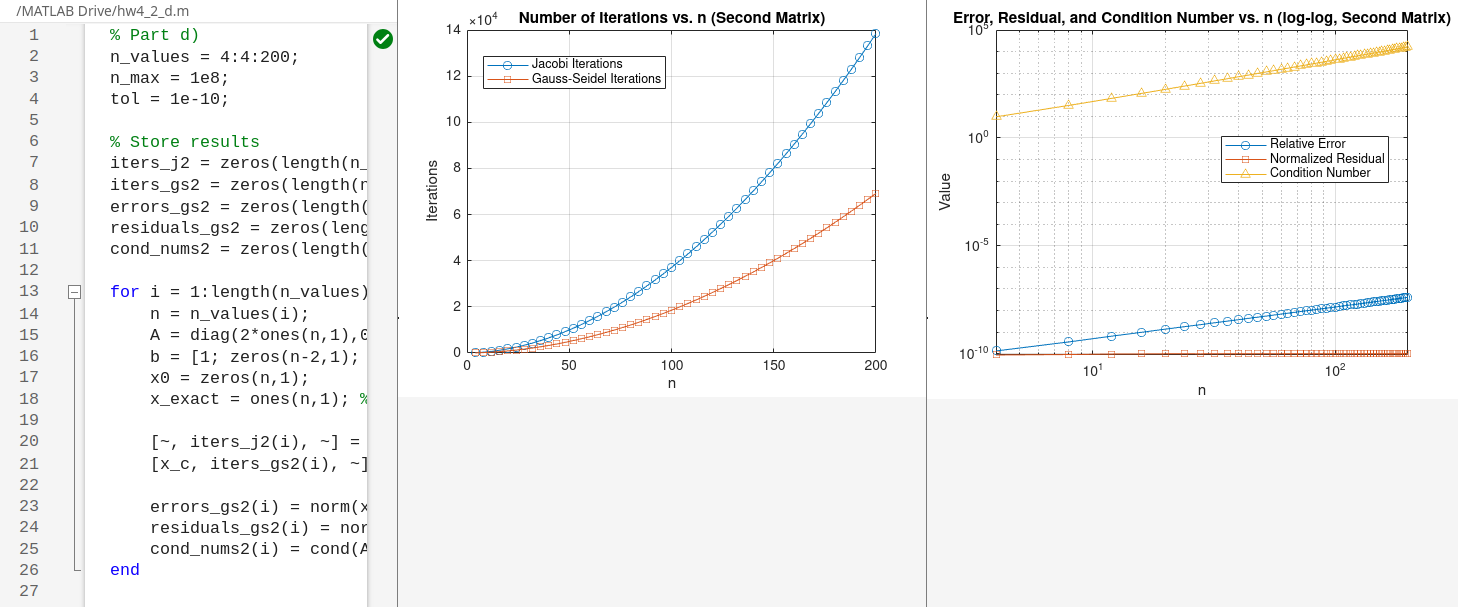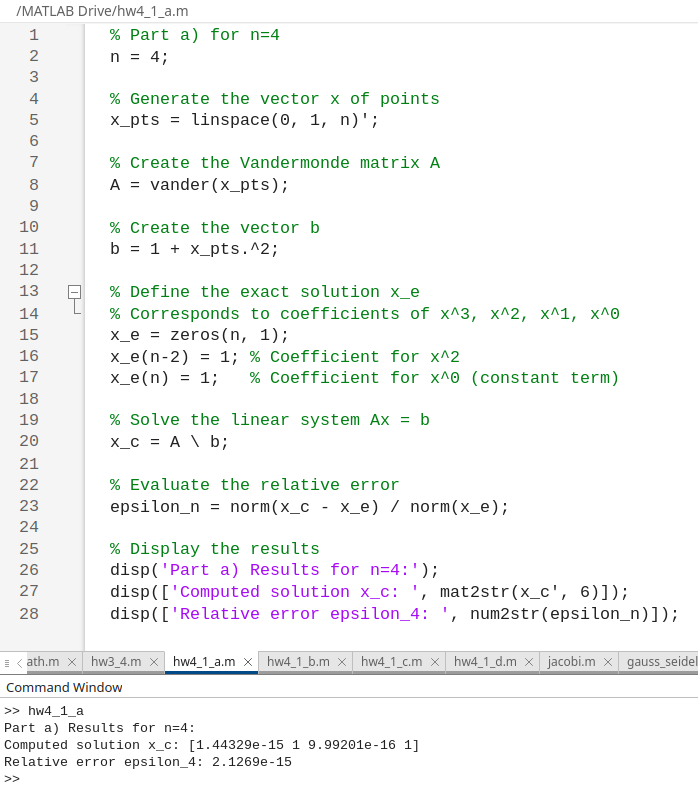
Math6003 Hw4
Ex 1
a
The result of hw4_1_a.m:
Vandermonde matrices are known to be ill-conditioned, with the condition number growing exponentially with $n$.
d
This tridiagonal matrix is well-conditioned. Its condition number grows polynomially with $n$ (like $O(n^2)$). The error $\epsilon_n$ should grow much more slowly than in the Vandermonde case, exhibiting polynomial rather than exponential growth. The residual $r_n$ will be a better, though not perfect, indicator of the true error compared to the previous case.
Comments on the obtained results:
- $\textbf{Error Growth:}$ The relative error $\epsilon_n$ for the tridiagonal system grows polynomially with $n$, which is significantly slower than the exponential growth observed for the Vandermonde matrix. This will be visible as a straight line on the
loglogplot. - $\textbf{Conditioning:}$ The dramatic difference in error behavior is due to the condition number. The Vandermonde matrix is severely ill-conditioned, whereas the tridiagonal matrix is well-conditioned.
- $\textbf{Residual as an Error Indicator:}$ For the well-conditioned tridiagonal matrix, the normalized residual $r_n$ and the relative error $\epsilon_n$ have much closer values. The residual is a far more reliable indicator of the true error in this case than it was for the Vandermonde system.
Ex 2
a
The task is to complete the files $jacobi.m$ and $gauss_seidel.m$. These files implement iterative methods based on a matrix splitting $A = P - (P-A)$, where $P$ is the preconditioner. The iterative update can be expressed as $x^{(k+1)} = x^{(k)} + z^{(k)}$, where $z^{(k)}$ is the solution to $Pz^{(k)} = r^{(k)}$, and $r^{(k)} = b - Ax^{(k)}$ is the residual.
For the $\textbf{Jacobi method}$, the preconditioner P is the diagonal of A. For the $\textbf{Gauss-Seidel method}$, P is the lower triangular part of A. The missing lines implement the calculation of the residual, the update step, and the storing of the residual norm at each iteration.
jacobi.m:
1 | function [x, iter, res]= jacobi(A,b,x0,nmax,tol) |
gauss_seidel.m:
1 | function [x, iter, res]= gauss_seidel(A,b,x0,nmax,tol) |
b
I solve the system for $n=4$ with the tridiagonal matrix $A$ having $2.5$ on the diagonal and $-1$ on the off-diagonals. The right-hand side is $b=(1.5,0.5,0.5,1.5)^{\top}$. The initial guess is $x^{(0)}=0$, tolerance is $10^{-10}$, and max iterations is $10^8$. I compare the number of iterations and computing time.
The matrix $A$ is strictly diagonally dominant since $|a_{ii}| = 2.5 > \sum_{j \neq i} |a_{ij}|$ for all rows. This property guarantees that both methods will converge.
Guass-Seidek converges faster. ### c The analysis is repeated for the same matrix family with $n$ varying from 4 to 200. The exact solution is $x=(1,...,1)^{\top}$. I plot the number of iterations, the relative error $||x-x_{c}||/||x||$, and the normalized residual $||b-Ax_{c}||/||b||$ versus $n$. I also examine how the condition number of A changes with n.For this well-conditioned matrix (as shown in part e), the number of iterations grows very slowly with $n$. The condition number remains small and constant. The relative error and the normalized residual are very close in value, indicating that the residual is a good estimator of the error.
d
The analysis from (c) is repeated for the matrix $A$ with 2 on the diagonal and -1 on the off-diagonals , and $b=(1,0,…,0,1)^{\top}$. The exact solution is again $x=(1,…,1)^{\top}$. This matrix is only weakly diagonally dominant, so I expect slower convergence.
The number of iterations will grow much more rapidly with $n$. This is because, as shown in part (e), the condition number of this matrix grows quadratically with $n$, making the problem progressively harder to solve.
e
I use the given formula for the eigenvalues of a symmetric tridiagonal matrix $M$ with $a$ on the diagonal and $b$ on the off-diagonals:
$$ \lambda_{i}(M)=a+2b\cos\left(\frac{\pi i}{n+1}\right), \quad i=1,…,n $$
The condition number is $\kappa_2(A) = |\lambda_{max}|/|\lambda_{min}|$.
Case 1: Matrix from part (c)
Here, $a=2.5$ and $b=-1$. The eigenvalues are $\lambda_i = 2.5 - 2\cos(\frac{\pi i}{n+1})$.
- As $n\to\infty$, $\lambda_{max} \to 2.5 - 2(-1) = 4.5$.
- As $n\to\infty$, $\lambda_{min} \to 2.5 - 2(1) = 0.5$.
The condition number $\kappa(A)$ approaches a constant, $\kappa(A) \to 4.5 / 0.5 = 9$. This is consistent with the numerical results from part (c), explaining the fast and stable convergence.
Case 2: Matrix from part (d)
Here, $a=2$ and $b=-1$. The eigenvalues are $\lambda_i = 2 - 2\cos(\frac{\pi i}{n+1}) = 4\sin^2(\frac{\pi i}{2(n+1)})$.
- As $n\to\infty$, $\lambda_{max} \to 4\sin^2(\pi/2) = 4$.
- For large $n$, $\lambda_{min} = 4\sin^2(\frac{\pi}{2(n+1)}) \approx 4(\frac{\pi}{2(n+1)})^2 = \frac{\pi^2}{(n+1)^2}$.
The condition number $\kappa(A) \approx \frac{4}{\pi^2/(n+1)^2} = O(n^2)$. This quadratic growth in the condition number is consistent with the numerical results from part (d), explaining the significant increase in iterations with $n$.

